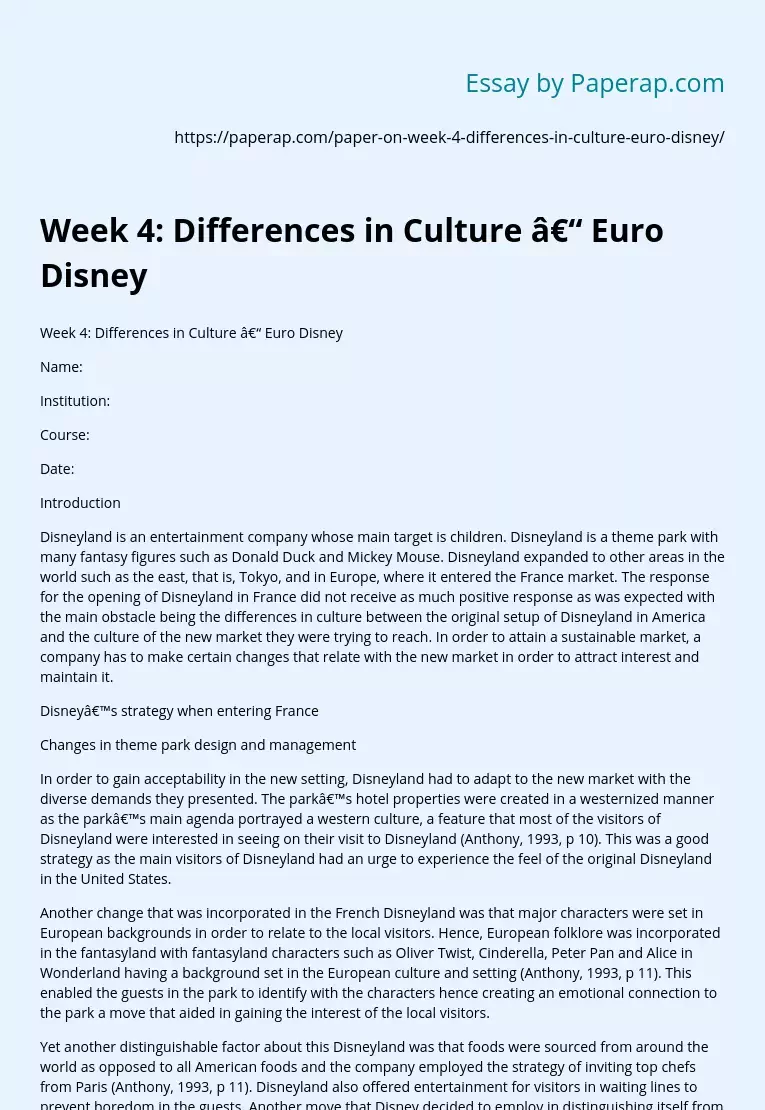Week 4: Differences in Culture – Euro Disney
Week 4: Differences in Culture – Euro Disney
Name:
Institution:
Course:
Date:
Introduction
Disneyland is an entertainment company whose main target is children. Disneyland is a theme park with many fantasy figures such as Donald Duck and Mickey Mouse. Disneyland expanded to other areas in the world such as the east, that is, Tokyo, and in Europe, where it entered the France market. The response for the opening of Disneyland in France did not receive as much positive response as was expected with the main obstacle being the differences in culture between the original setup of Disneyland in America and the culture of the new market they were trying to reach.
In order to attain a sustainable market, a company has to make certain changes that relate with the new market in order to attract interest and maintain it.
Disney’s strategy when entering France
Changes in theme park design and management
In order to gain acceptability in the new setting, Disneyland had to adapt to the new market with the diverse demands they presented.
The park’s hotel properties were created in a westernized manner as the park’s main agenda portrayed a western culture, a feature that most of the visitors of Disneyland were interested in seeing on their visit to Disneyland (Anthony, 1993, p 10). This was a good strategy as the main visitors of Disneyland had an urge to experience the feel of the original Disneyland in the United States.
Another change that was incorporated in the French Disneyland was that major characters were set in European backgrounds in order to relate to the local visitors.
Hence, European folklore was incorporated in the fantasyland with fantasyland characters such as Oliver Twist, Cinderella, Peter Pan and Alice in Wonderland having a background set in the European culture and setting (Anthony, 1993, p 11). This enabled the guests in the park to identify with the characters hence creating an emotional connection to the park a move that aided in gaining the interest of the local visitors.
Yet another distinguishable factor about this Disneyland was that foods were sourced from around the world as opposed to all American foods and the company employed the strategy of inviting top chefs from Paris (Anthony, 1993, p 11). Disneyland also offered entertainment for visitors in waiting lines to prevent boredom in the guests. Another move that Disney decided to employ in distinguishing itself from other entertainment spots in France was not serving wine to the visitors, a custom that was different from what the French were accustomed to.Maintained customs in the park designs
The feel of the park had to be maintained to ensure that visitors received the experienced they expected. The layout of the park was similar to most of the layout in the American Disneyland with similar rides and land attractions (Anthony, 1993, p 10). Disneyland was themed, with set acres of land, full of adventure where every themed land would portray a set adventurous detail, some represented fantasy, and others adventure, while others represented military and the main street in the United States. Another custom that Disneyland maintained was the use of same characters that had grown to be the signature characters. This was because these characters acted and the identity of the viewers.
The service delivery was up to per with the company employing an in-built personnel-training institution to ensure that the service delivered to the consumers surpassed the expectations (Anthony, 1993, p 5). Managers and supervisors were also cross-trained providing vigorous training for both the employees and employers. This resulted in well-rounded employees who led to the achievement of the company goals of provision of high qualities of conduct resulting in the best experiences for the employees.
References
Anthony, R. (1993). “Euro Disney: The First 100 Days”. Harvard Business School: Boston. Print.
Gladwell, M. (2002). “The Tipping Point: How Little Things Can Make a Big Difference”. Back Bay Books. Print.
Week 4: Differences in Culture – Euro Disney. (2018, Aug 04). Retrieved from https://paperap.com/paper-on-week-4-differences-in-culture-euro-disney/

